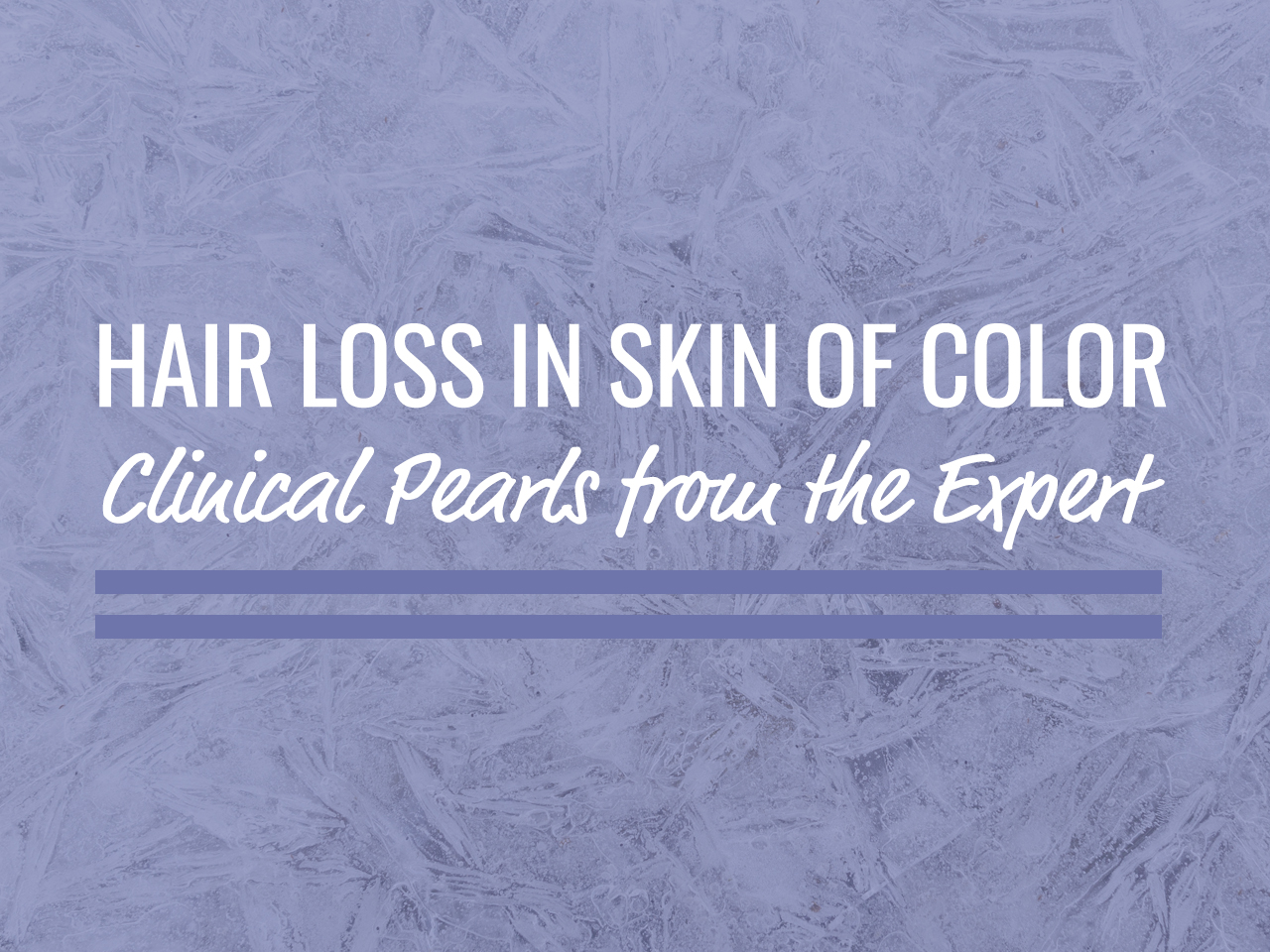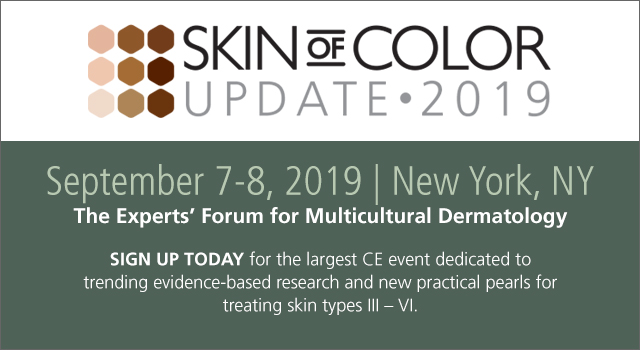In an informative 20-minute session on hair loss in skin of color patients,
Dr. Valerie Callender focused on how structural differences in afrocentric hair and cultural haircare practices contribute to the high prevalence of alopecia in African American women in particular.
*Clinical pearls* from this session are bolded, underlined, and marked with asterisks.
Dr. Callender started her lecture with an introduction to alopecia – one of the most common dermatologic concerns of African American patients. Given that healthy hair is considered to be a sign of beauty, youth, and attractiveness, alopecia has a huge negative impact on the quality-of-life of affected individuals. The psychological comorbidity of hair loss makes it essential that physicians understand the etiology, diagnosis, and treatment of common causes of scarring and non-scarring alopecia. *It is important to note that patients can present with BOTH scarring and non-scarring alopecia, and both must be considered during the work-up*.
When evaluating alopecia in African American patients, several differences in Afro-ethnic hair (versus Asian and Caucasian hair) are important to consider. Black hair is tightly coiled or spiraled and elliptical/flattened on cross-section (compared to straight, wavy or helical hair in Caucasians and straight/round hair in Asians). These textural differences result in ethnic-specific grooming practices, including thermal and chemical straightening, permanent weaving, natural styles, hair weaving and extensions, and use of hair maintenance products, which will be discussed later. Overall, African Americans are more prone to certain hair and scalp disorders due to the fragile inner structure of the hair and significant hair knotting, intertwining, and coiling that leads to additional breakage while grooming.
During an office visit for alopecia, it is important to ask about medical history, hair grooming history (i.e. use of thermal and chemical straightening, weaves, braids, etc.), and presence of any scalp symptoms, including itching, scaling, pain, and dysesthesias. *Dr. Callender recommends that physicians note the patient’s hairstyle at each visit and take photographs to monitor hairstyle and severity of alopecia.* Examination should include visual inspection, palpation, hair pull test, and dermoscopy. *You must ALWAYS touch the scalp during examination of alopecia.*Laboratory evaluation is also important; fungal/bacterial cultures and trichogram may be indicated in some cases. Punch biopsy of the scalp is also a useful diagnostic tool. It is important to note that *African Americans have a lower number of hair follicles and lower number of average hairs per unit area than Caucasians. Therefore, you must indicate that the patient is of African descent when sending a biopsy to dermatopathology.*
Lastly, Dr. Callender spoke about unique ethnic hairstyles and hair grooming practices, many of which contribute to hair breakage and trauma. These hair care practices are essential to recognize when treating African Americans patients with alopecia:
- Thermal straightening:Use of hot combs, electric flat irons and/or curling irons with heat of 150-500ºF may lead to weakening and breakage of the hair.
- Chemical straightening: Chemical relaxers damage/rearrange the cysteine disulfide bonds of the hair, resulting in permanent straightening of the hair. Touch-ups are typically required every 6-8 weeks.
- Brazilian keratin hair straighteners: These treatments temporarily straighten the hair (lasts 10-12 weeks) by sealing keratin and preservation solution into the hair with a flatiron. Formaldehyde, which is released up application of heat, has been associated with conjunctivitis, allergic reactions, and carcinogenic conditions.
- Hair coloring: Hair coloring is very common among African American women. There is a risk of contact dermatitis from the dyes. If left on too long, hydrogen peroxide and other bleaching agents dry out the hair and contribute to hair breakage. Patients should use good moisturizers, keep up with their stylists for deep protein or moisturizing conditioners, and trim their hair frequently.
- Hair weaving: Hair weaving involves attaching (sewing or gluing) synthetic or natural hair to an individual’s braided hair. Tight weaves may lead to traction alopecia. The sewing process may cause trauma and infection, resulting in traction folliculitis. *If you see pustules on the scalp of a patient with weaves, perform a bacterial culture to rule out MRSA infection. The glue used to attach hair contains latex and may be associated with allergic reactions.*
- Braiding: Braids are easy to maintain, but may result in traction alopecia, traction folliculitis, contact dermatitis to added synthetic hair, and seborrheic dermatitis.
- Hair oils: There are no studies showing that castor, coconut or argan oil induce hair growth, but these oils are good for moisturizing. Use of these oils along the anterior hairline may cause pomade acne. *To avoid pomade acne, Dr. Callender recommends hair oils or pomades that are light and contain silicone-based ingredients such as dimethicone*
In conclusion, afro-centric hair grooming practices can be associated with hair breakage (acquired trichorrhexis nodosa), central centrifugal cicatricial alopecia (CCCA), and traction alopecia. *Ideally, individuals with Afro-centric hair should wash their hair every 2 weeks, deep condition and moisturize after shampooing, moisturize hair daily or every other day, and limit exposure to chemicals and heat.* All patients should be educated on proper hair care practices so that adverse events can be avoided and treatment response can be improved.
*Dr. Valerie Callender presented this lecture at the 2018 Skin of Color Seminar Series (now the Skin of Color Update).


